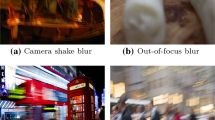Abstract
The text on one side of historical documents often seeps through and appears on the other side, so the bleed-through is a common problem in historical document images. It makes the document images hard to read and the text difficult to recognize. To improve the image quality and readability, the bleed-through has to be removed. This paper proposes a global and local features extraction based bleed-through removal method. The Gaussian mixture model is used to get the global features of the images. Local features are extracted by the patch around each pixel. Then, the extreme learning machine classifier is utilized to classify the scanned images into the foreground text and the bleed-through component. Experimental results on real document image datasets show that the proposed method outperforms the state-of-the-art bleed-through removal methods and preserves the text strokes well.







Similar content being viewed by others
References
Dubois, E., & Pathak, A. (2001). Reduction of bleed-through in scanned manuscript documents. In Proceedings of image processing, image quality, image capture systems conference (pp. 177–180).
Tonazzini, A., Bedini, L., & Salerno, E. (2004). Independent component analysis for document restoration. Document Analysis and Recognition, 7(1), 17–27.
Tonazzini, A., Bedini, L., & Salerno, E. (2006). A Markov model for blind image separation by a mean-field em algorithm. IEEE Transactions on Image Processing, 15(2), 473–482.
Rowley-Brooke, R., Pitie, F., & Kokaram, A. (2013). A non-parametric framework for document bleed-through removal. In Proceedings of IEEE conference on computer vision and pattern recognition (Vol. 9, pp. 2954–2960).
Wolf, C. (2009). Document ink bleed-through removal with two hidden Markov random fields and a single observation field. IEEE Transactions on Pattern Analysis and Machine Intelligence, 32(3), 431–447.
Wolf, C., & Doermann, D. (2002). Binarization of low quality text using a Markov random field model. In Proceedings of international conference on pattern recognition (Vol. 3, pp. 160–163).
Liu, Y., & Srihari, S. N. (1997). Document image binarization based on texture features. IEEE Transactions on Pattern Analysis and Machine Intelligence, 19(5), 540–544.
Solihin, Y., & Leedham, C. G. (1999). Integral ratio: A new class of global thresholding techniques for handwriting images. IEEE Transactions on Pattern Analysis and Machine Intelligence, 21(8), 761–768.
Lelore, T., & Bouchara, F. (2011). Super-resolved binarization of text based on the FAIR algorithm. In Proceedings of international conference on document analysis and recognition (Vol. 18, No. 21, pp. 839–843).
Su, B., Lu, S., & Tan, C. L. (2010). Binarization of historical document images using the local maximum and minimum. In Proceedings of international workshop on document analysis systems (pp. 159–166).
Lu, S., Su, B., & Tan, C. L. (2010). Document image binarization using background estimation and stroke edges. International Journal on Document Analysis and Recognition, 13(4), 303–314.
Moghaddam, R. F., & Cheriet, M. (2012). Adotsu: An adaptive and parameterless generalization of otsu’s method for document image binarization. Pattern Recognition, 45(6), 2419–2431.
Nafchi, H. Z., Moghaddam, R. F., & Cheriet, M. (2013). Historical document binarization based on phase information of images. In Proceedings of computer vision (pp. 1–12).
Gatos, B., Pratikakis, I., & Perantonis, S. J. (2006). Adaptive degraded document image binarization. Pattern Recognition, 39(3), 317–327.
Otsu, N. (1979). A threshold selection method from gray-level histograms. IEEE Transactions on Systems Man and Cybernetics, 9(1), 62–66.
Rosenfeld, A., & Smith, R. C. (1981). Thresholding using relaxation. IEEE Transactions on Pattern Analysis and Machine Intelligence, 3(5), 598–606.
Niblack, W. (1985). An introduction to digital image processing. Graphics Programming and Theory, 25(4), 72.
Sauvola, J., & Pietikinen, M. (2000). Adaptive document image binarization. Pattern Recognition, 33(2), 225–236.
Mukherjee, D., Wu, Q. M. J., & Nguyen, T. M. (2014). Gaussian mixture model with advanced distance measure based on support weights and histogram of gradients for background suppression. IEEE Transactions on Industrial Informatics, 10(2), 1086–1096.
Greenspan, H., Goldberger, J., & Mayer, A. (2004). Probabilistic space-time video modeling via piecewise GMM. IEEE Transactions on Pattern Analysis and Machine Intelligence, 26(3), 384–396.
Carson, C., Belongie, S., Greenspan, H., & Malik, J. (1999). Blobworld: Image segmentation using expectation-maximization and its application to image querying. IEEE Transactions on Pattern Analysis and Machine Intelligence, 24(8), 1026–1038.
Pernkopf, F., & Bouchaffra, D. (2005). Genetic-based EM algorithm for learning Gaussian mixture models. IEEE Transactions on Pattern Analysis and Machine Intelligence, 27(8), 1344–1348.
Huang, G. B., Zhu, Q. Y., & Siew, C. K. (2006). Extreme learning machine: Theory and applications. Neurocomputing, 70(1), 489–501.
Dong, Y., & Xu, S. (2007). A new directional weighted median filter for removal of random-valued impulse noise. IEEE Signal Processing Letters, 14(3), 193–196.
Lee, D. S. (2005). Effective Gaussian mixture learning for video background subtraction. IEEE Transactions on Pattern Analysis and Machine Intelligence, 27(5), 827–832.
Huang, G. B., Zhu, Q. Y., & Siew, C. K. (2004). Extreme learning machine: A new learning scheme of feedforward neural networks. In Proceedings of international joint conference on neural networks (pp. 985–990).
Rowley-Brooke, R., Pitie, F., & Kokaram, A. (2012). A ground truth bleed-through document image database. Theory and Practice of Digital Libraries, 7489, 185–196.
Acknowledgments
This paper is supported by the National Natural Science Fund of China for Distinguished Young Scholars (No. 61325007) and the National Natural Science Fund of China for International Cooperation and Exchanges (No. 61520106001).
Author information
Authors and Affiliations
Corresponding author
Rights and permissions
About this article
Cite this article
Hu, X., Lin, H., Li, S. et al. Global and Local Features Based Classification for Bleed-Through Removal. Sens Imaging 17, 9 (2016). https://doi.org/10.1007/s11220-016-0134-7
Received:
Revised:
Published:
DOI: https://doi.org/10.1007/s11220-016-0134-7




